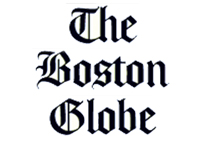
By Mark Feeny
WINCHESTER -- Martin Schoeller has one of the simplest, yet most distinctive, styles of any photographer working today. He shoots color portraits that are big, very big. The 19 examples that are in "Close Up," which runs at the Griffin Museum of Photography through April 15, are all about 3 1/2 feet by 4 feet or 2 1/2 feet by 3 1/2 feet. They feel even bigger than they actually are because -- and this is the other thing that distinguishes Schoeller's work -- they are all tight close-ups, minus any frame of reference.
A German, Schoeller came to America in 1993 to work as Annie Leibovitz's assistant. He eventually followed in her celebrity-chronicling tracks, working for such magazines as Rolling Stone, Esquire, and The New Yorker.
Leibovitz and Schoeller may share subject matter, but the great influences on his work have been August Sander and Bernd and Hilla Becher . From Sander, he took an almost-clinical approach to portraiture, an awareness of the camera as taxonomic tool. From the Bechers, who specialize in photographs of industrial architecture, such as silos and warehouses, he learned the power of objectivity and straightforwardness.
What Schoeller offers, you might say, is the face as water tank: a structure of being rather than state of being. His work owes more to autopsy than portraiture. We see Jack Nicholson and John McEnroe and Angelina Jolie and the rest up close and impersonal. They stare back at the camera, impassive, well aware that a smile or grimace at so short a distance would overpower the lens.
It's as if Schoeller plants his camera at the intersection of optics and psychology. Past a certain spatial point, personality (the sitter's) battles with myopia (the viewer's). Intimacy becomes a function of dermatology rather than emotion. The face is all: the mug shot as monument. Easter Island has totems. Our Age of Celebrity has Schoeller's portraits.
Famous appearances can alter when seen in this way. Who'd have thought Nicholson could ever look very nearly normal. Andre Agassi has a haunted aspect. The swollen majesty of Magic Johnson's head makes it resemble a slightly ovoid basketball.
The merest accoutrements can assume a near-monstrous importance on these faces. Which has more visual weight (and a very weighty weight, at that): Donald Rumsfeld's rimless glasses? Marilyn Manson's rivulets of red face paint? Judi Dench's eye liner? Tammy Faye Bakker's forest of false eyelashes?
Physical features which we usually take in as parts of a coherent facial whole stand out and appear almost discrete. How did Robert De Niro get such a big nose? On the matter of mouths, forget Jolie. The reason Meryl Streep has the most animated face here is because of the ever-so-slight parting of her lips. It's a detail not noticed in a smaller portrait. Or the prominence of eyes creates an unexpected competition among Rumsfeld, Lance Armstrong, and Helen Mirren for best gunslinger squint. (The smart money's on Mirren.)
In some ways, Schoeller's technique works best when we don't have a set of preconceptions about the sitter. The single most arresting sight in this arresting show is the avalanche of freckles on the face of a red-haired teenager named Frankie Velilla . A close second is the shock of seeing the much-damaged face of Joseph Mosner , an Army sergeant wounded by a bomb blast in Iraq. Or there are three African men Schoeller photographed in 2005. Their matter-of-fact beauty is glorious, the leathery effulgence of their skin akin to a living mahogany.
Vidor, Texas, where Dave Anderson took the 14 black-and-white photographs that make up "Rough Beauty," which is also at the Griffin through April 15, is very, very far from the world of Hollywood stars -- if not Tammy Faye's. A chained pit bull sits before a wrecked truck cab. A battered trailer has not one but five signs advertising shrimp for sale. A little blond girl has plopped herself down in an empty bucket of spackling compound. Another little girl, this one (unlike the blonde) without a visible tattoo, wears princess garb , and a ribbon declaring her queen of the local barbecue festival.
These are strong, tough, clear-eyed pictures with tales to tell and no judgments to offer. Schoeller's photographs are all about the absence of context, Anderson's are so thickly encrusted with it each is a short story waiting to happen.